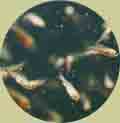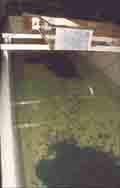|
Hatchery Production
of Carp Seed
The technique of breeding fish by other than its natural course is known as Induced
Breeding. Induced breeding techniques have been developed for production of quality
fish seed of culturable varieties. It is one of the most dependable methods of producing
pure seed of desired species of fish.
Common carp breeding happas
Method
of Induced Breeding
Hypophysation
The technique of breeding the fish by administering pituitary gland extract injection
is known as induced breeding or hypophysation. The pituitary gland secretes several
hormones of which Gonadotropin is the most important for breeding.
The increasing demand of fish pituitaries has now been solved to some extent by
the introduction of Human Chorionic Gonadotropin (HCG), now readily available in
the market. The HCG is now increasingly becoming popular due to its low cost. A
mixture of HCG and pituitary hormone extract in definite proportion are employed
successfully for breeding fish.
Collection of pituitary gland
Glands are collected from ripe fish by removing the upper part of the skull (scalp)
by a sharp knife or a bone cutter. After removing the scalp, the brain is exposed
which is then cut from the posterior end and lifted up anteriorly. As soon as the
brain is lifted the gland can be seen located in the cavity covered by a thin membrane.
It is carefully picked up with the help of tweezers and kept immersed in a cavity
block or a petri dish in absolute alcohol under cover.
Preservation and storage of pituitary gland
While exposing and removing the glands great care is taken to avoid any contact
with water. It is most important because the hormone of the pituitary gland is soluble
in water. There are three methods for preservation of pituitary glands
i) preservation in absolute alcohol
ii) preservation in acetone
iii) preservation by quick freezing
Identification and selection of breeders for spawning
The identification the sex is made on the basis of the external characters. The
mature males are distinguished from the females by the presence of denticulation
on the dorsal surface of the pectoral fin, which is rough to touch.
Further, in males the abdomen is comparatively flat and the vent is not swollen
but they ooze milt at slight pressure on their abdomen.
The ripe females have soft and bulging abdomen with swollen pinkish genital opening.
The presence or absence of pre-anal ridge is also taken into consideration as a
sign of maturity for selection of female breeders.
For the production of quality seed and better growth, breeders of standard quality
may be selected viz., Catla-3 kg and above, Rohu, Grass and Silver carp-2 kg and
above, Mrigal and Calbasu-1 kg and above.
Maintenance of breeders
Farm raised breeders give better results. The best time for collection is from November
till March. The optimal rate of stocking may be 2000-2500 kg/ha.
Pond/tank stocked with grass carp as the major species need not be manured regularly.
Organic manure along with low dose of single super-phosphate (17 to 20 kg/ha) may
be applied at fortnightly intervals in the pond where catla and silver carp is stocked
as major species.
For other species feed prepared by mixing deoiled rice bran and oil cake at the
rate of 1-2% of the body weight of fish stock is desired in the initial stages.
Fishmeal containing 30% protein could be a better substitute for oil cake at the
later stage (advent of the spring).
The mature male and female breeders are segregated and stocked sex-wise in separate
ponds about 1-2 months before their breeding season and their genetic conditions
and stage of maturity are checked periodically.
Breeding
technique
After selection of brood fishes from the segregated brooder ponds they are kept
in the happas at fish farms or in fish seed hatcheries for about 6-7 hours for conditioning.
After proper conditioning the individual brood fish is weighed in a hand net using
a spring balance. The breeders are then ready to receive injection.
Determination of dosage for injection
Doses of pituitary gland extract are calculated on the basis of miligrams of pituitary
gland per kg body weight of the recipient fish. Spawning of carp may be obtained
by administration of a single dose of 5-10 mg of pituitary gland per kg body weight
to the female breeders.
In males a low dose of 2 mg/kg body weight is usually given. Better results are
however obtained by injecting a preliminary dose of 2-3 mg/kg body weight to the
female fish alone and a second dose of 5-8 mg/kg body weight after an interval of
6 hours. The males receive only a single dose of 2-3 mg/kg body weight at the time
of 2nd injection to the female. Both the sexes are then put together in a definite
ratio in circular spawning pool inside indoor hatchery.
Preparation of gland extract
Once proper dosages are determined, the quantity of glands required for injecting
the breeders is calculated. The required quantity of glands is then taken out from
vials, dried on a filter paper and macerated in a tissue homogenizer with a little
distilled water or 0.3% common salt solution. The homogenized glands are then centrifuged
and the supernatant liquid is decanted and diluted with the same solvent to a known
volume. the following dilutions are recommended.
|
Weight of brooder
|
Prepatory dose
|
Final dose
|
|
1.0 to 2.0 kg
|
0.50 cc/fish
|
0.75 cc/fish
|
|
Above 2 kg
|
0.75 cc/fish
|
1.50 cc/fish
|
Method of injection
Intra-muscular injection of fish pituitary extract is administered usually in the
region of the caudal peduncle a little above or below the lateral line region or
near the shoulder region. For injecting the fish, the needle is inserted under a
scale, parallel to the body of the fish and then pierced into the muscles at an
angle. A 2 ml graduated hypodermic syringe is most convenient for injecting most
of the fishes. The size of the needle depends upon the size of the breeder to be
injected.
Breeding environment
Success of spawning by hypophysation depends on the hydrological and climatic conditions.
Temperature is one of the most important factors. It has been observed that 25-28oC
is most conducive for breeding. However, spawning could be induced at or below this
temperature range. The percentage of fertilisation and hatching under uncontrolled
conditions is not very satisfactory. Circulation of fresh water containing 5-9 mg/litre
of oxygen promotes better success in spawning, higher fertilisation of eggs and
higher recovery of hatchlings from fertilised eggs.

Induced breeding in carps
|

Roe from gravid female
|

Milt from mature male
|

External Fertilization
|

Fry of Common carps
|

Fingerlings of Common Carp
|

Fingerlings of Common carp ready to be stocked
|
(Source: www.members.rott.chello.nl)
Top
|